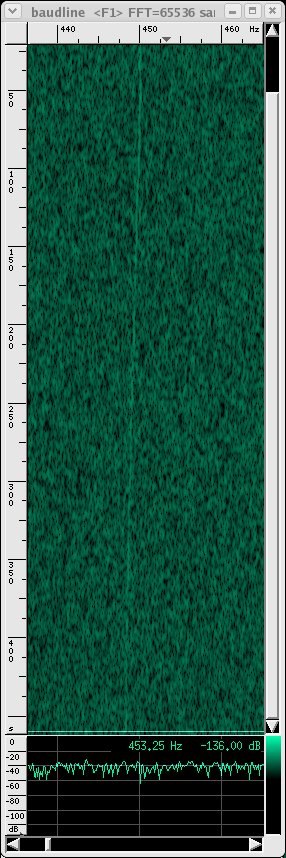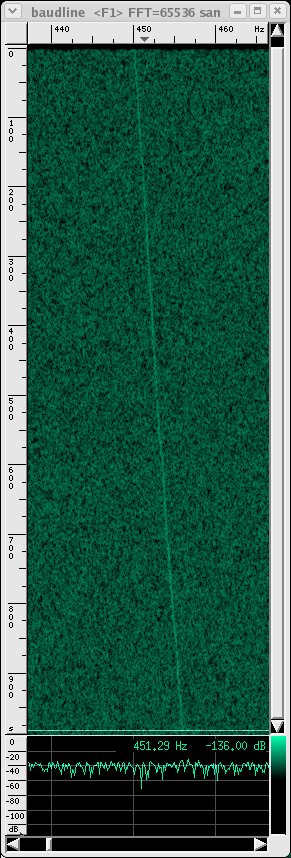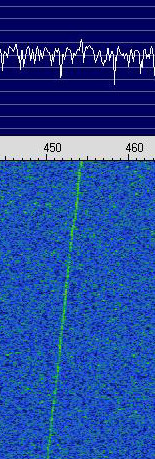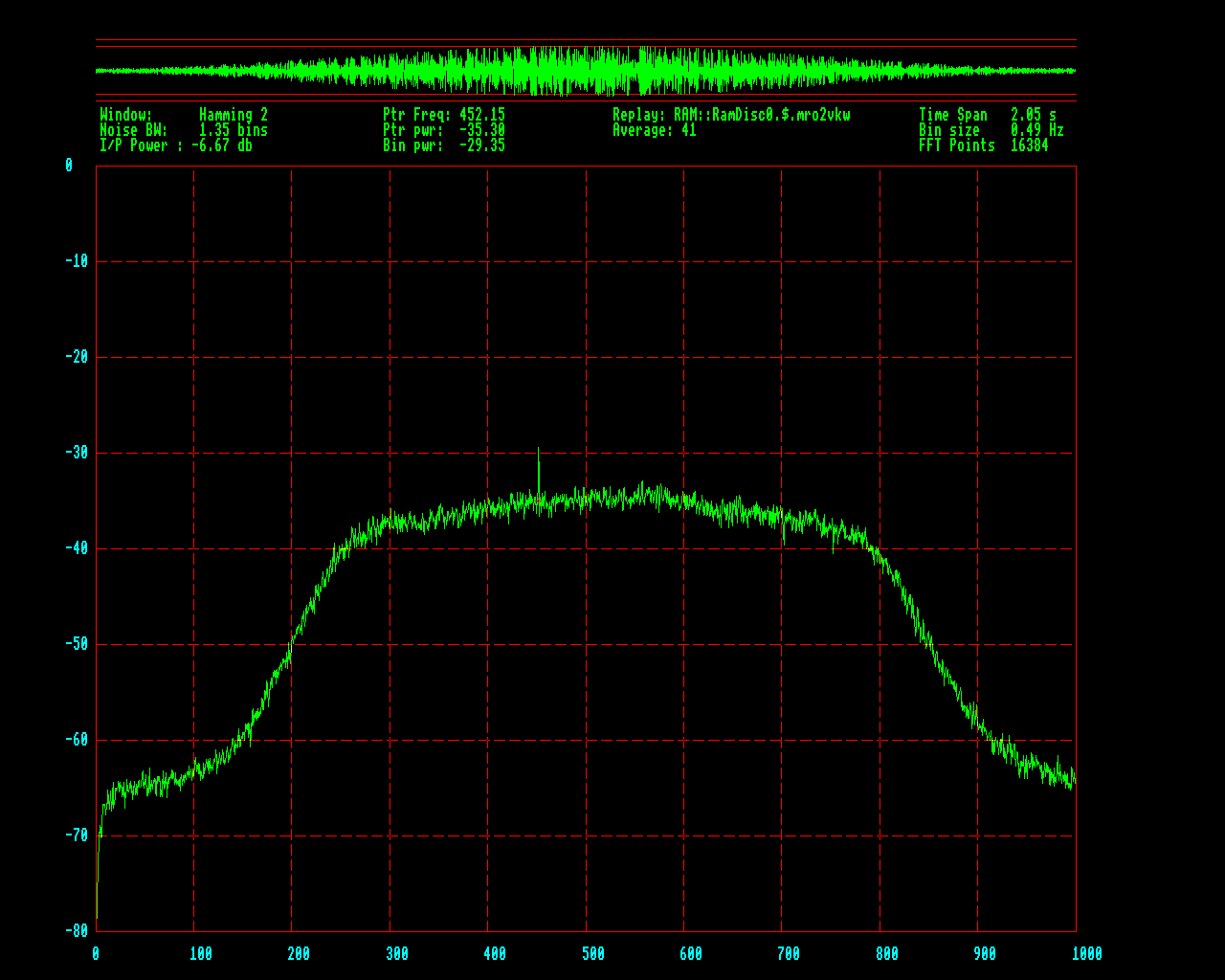2 x 20 el. X-Yagi, RHCP (KLM 435-40CX, nominal gain 15.2 dBdC @ 436 MHz)
Az/El controlled
4-cavity filter 435-438 MHz, insertion loss @ 437 MHz approx. -1.9 dB
Preamplifier: SP-7000 (nominal noise figure 0.9 dB, amplification 20 dB)
Receiver: IC-970 with TCXO (CR-293) and 500 Hz CW-Filter (LF-132)
Frequency calibration: 3rd overtone of IC-821 at 145.69792 MHz,
checked with 225 MHz Frequency Counter (HP5382A)
FFT-Software: Baudline
Sep 22 05:54 mro1vkw.wav 3696044 bytes (462 sec) Sep 22 07:32 mro2vkw.wav 7912044 bytes (989 sec)The wav files can be accessed for further inspection: mro1vkw.wav mro2vkw.wav
Date__(UT)__HR:MN Azi_(a-appr)_Elev delta deldot Rx frequency **************************************************************** (437093+x)kHz $$SOE 2005-Sep-22 05:45 *m 289.9973 32.4927 1.4004676E+07 4.30381 0.7250 2005-Sep-22 05:46 *m 290.1478 32.3356 1.4004934E+07 4.30402 0.7247 2005-Sep-22 05:47 *m 290.2984 32.1787 1.4005192E+07 4.30423 0.7244 2005-Sep-22 05:48 *m 290.4488 32.0220 1.4005451E+07 4.30444 0.7241 2005-Sep-22 05:49 *m 290.5993 31.8654 1.4005709E+07 4.30464 0.7238 2005-Sep-22 05:50 *m 290.7497 31.7089 1.4005967E+07 4.30483 0.7235 2005-Sep-22 05:51 *m 290.9001 31.5526 1.4006226E+07 4.30502 0.7232 2005-Sep-22 05:52 *m 291.0504 31.3965 1.4006484E+07 4.30521 0.7230 2005-Sep-22 05:53 *m 291.2007 31.2405 1.4006742E+07 4.30539 0.7227 2005-Sep-22 05:54 *m 291.3510 31.0847 1.4007000E+07 4.30557 0.7224 2005-Sep-22 05:55 *m 291.5013 30.9291 1.4007259E+07 4.30574 0.7222 $$EOE $$SOE 2005-Sep-22 07:15 *m 303.6360 19.0892 1.4027933E+07 4.30398 0.7248 2005-Sep-22 07:16 *m 303.7910 18.9500 1.4028191E+07 4.30376 0.7251 2005-Sep-22 07:17 *m 303.9462 18.8112 1.4028450E+07 4.30354 0.7254 2005-Sep-22 07:18 *m 304.1014 18.6726 1.4028708E+07 4.30332 0.7257 2005-Sep-22 07:19 *m 304.2568 18.5343 1.4028966E+07 4.30309 0.7261 2005-Sep-22 07:20 *m 304.4123 18.3962 1.4029224E+07 4.30286 0.7264 2005-Sep-22 07:21 *m 304.5680 18.2583 1.4029482E+07 4.30262 0.7267 2005-Sep-22 07:22 *m 304.7237 18.1208 1.4029740E+07 4.30238 0.7271 2005-Sep-22 07:23 *m 304.8796 17.9834 1.4029999E+07 4.30213 0.7275 2005-Sep-22 07:24 *m 305.0357 17.8464 1.4030257E+07 4.30188 0.7278 2005-Sep-22 07:25 *m 305.1918 17.7096 1.4030515E+07 4.30162 0.7282 2005-Sep-22 07:26 *m 305.3481 17.5731 1.4030773E+07 4.30136 0.7286 2005-Sep-22 07:27 *m 305.5046 17.4368 1.4031031E+07 4.30110 0.7290 2005-Sep-22 07:28 *m 305.6611 17.3008 1.4031289E+07 4.30083 0.7294 2005-Sep-22 07:29 *m 305.8178 17.1650 1.4031547E+07 4.30055 0.7298 2005-Sep-22 07:30 *m 305.9747 17.0296 1.4031805E+07 4.30027 0.7302 2005-Sep-22 07:31 *m 306.1317 16.8944 1.4032063E+07 4.29999 0.7306 2005-Sep-22 07:32 *m 306.2888 16.7594 1.4032321E+07 4.29970 0.7310 $$EOE
Since the exact recording times havn't been registered, only the end of recording is known by the time of storing the file, by the minute only. Therefore some approximations have to be done.
The interval 05:46-05:54 (480 sec) shows a calculated drift of -2.3 Hz. Interpolation for the first recording period of 462 seconds yields -2.2 Hz.
The interval 05:16-07:32 (960 sec) shows a calculated drift of +5.9 Hz. Extrapolation for the second recording period of 989 seconds yields +6.1 Hz.
Difference of frequencies at the begin of the two recording periods is 0.4 Hz.
05:45:20-05:53:02 0.7249-0.7227 -2.2 Hz 07:15:20-07:31:49 0.7249-0.7309 +6.0 Hz
Date__(UT)__HR:MN delta signal
******************************** delay
(sec)
2005-Sep-22 05:45 1.4004676E+07 46.71
2005-Sep-22 05:55 1.4007259E+07 46.72
2005-Sep-22 07:15 1.4027933E+07 46.79
2005-Sep-22 07:32 1.4032321E+07 46.81
MRO output: 10 W, 0 dBi -> +40 dBm path loss (437.1 MHz, 14 10⁶ km): -228.2 dB antenna gain: +17 dBdC estimated signal strength: -171 dBm overall receiver noise figure (optimistic ?): 3 dB equivalent noise bandwidth: 0.5 Hz


The signal shows up with transform size 8192 and higher (default is 2048).

 Second quote:
Second quote:
(S+N)/N = -29.36 - (-35.30) dB
= 5.95 dB
So the signal-to-noise ratio is
S/N = 10^(5.95/10) - 1
= 2.94:1
Now, the bin noise bandwidth is 1.35*0.49 = 0.66 Hz
So the carrier-to-noise ratio is:
CNR = 2.94*0.66 Hz
= 1.94:1 Hz
= 2.9 dB-Hz
The file in general, however averages around 2 dB-Hz.

Updated: 2005-10-04